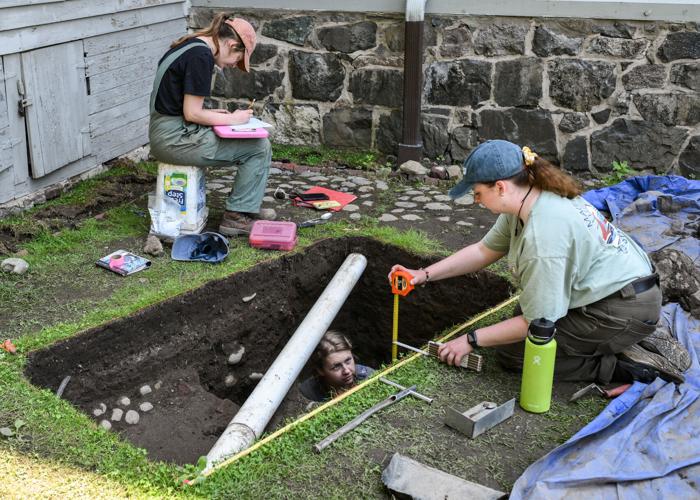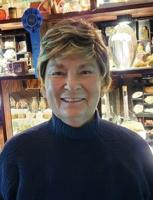UMass Boston student archaeologists and faculty have finished up their five-week long excavation of the Jeremiah Lee Mansion and Brick Kitchen property in Marblehead , conducted by The Fiske Center for Archaeological Research and the Marblehead Museum.
After uncovering over 10,000 artifacts in a two-week period last summer, archaeologists returned for a longer dig with a larger crew, predicting at least triple the amount of artifacts this time around.
“Last summer we did almost exclusively little test pits — foot-and-a-half by foot-and-a-half, just to get a sense of what was where and how deep. We hit some cobbled surfaces, so this year we are coming back to follow up and do bigger expanses,” explained Christa Beranek, Research Scientist for the Fiske Center for Archaeological Research, during one of the work days.
The dig is part of the Marblehead Museum’s reinterpretation project, which aims to use archaeology to incorporate the stories of underrepresented individuals, such as the slaves who lived and worked on the property, into the public understanding of Marblehead’s history. Along with a $40,000 grant from the National Endowment for the Humanities, this project was prompted by the museum acquiring the former slave quarters next door to the Lee Mansion in 2021.
By using a ground-penetrating radar, or GPR, to scan wide areas of the property and then excavating, the team of archaeologists uncovered countless artifacts such as brick, mortar, several different ceramics, cobblestone walls, animal bones, plant remains, parasite eggs, nails, children’s toys, buttons, buckles, parts of buildings including an outhouse and barn, and a copious amount of pipes.
While they still need to be taken back to the lab at UMass Boston in order to be further analyzed and identified, the artifacts and landscape features uncovered are already helping to give insight into how the mansion’s previous occupants lived and interacted with the world around them.
“You can start to sort of put people and activities back into the space by figuring out what artifacts you find where, and also imagine how different people would have used the different spaces,” explained Beranek. “(For example), although it’s a very formal, nice recreational garden space today, the side yard would have had a barn where we found lots of animal bones. So it sort of flips our sense of what activities are happening where.”
Since the notoriously wealthy merchant and ship owner, Col. Jeremiah Lee finished building the house in 1768 and died in 1775, with the house being sold out of the family in the 1780s, the Lee period actually only represents a small window of time in the properties’ history. That being the case, the museum, archaeologists, and researchers are also interested in the people who came before and after, such as the Jackson family and the owners of the Marblehead Bank, which the mansion would be repurposed for in 1804.
Findings as seemingly inconsequential as animal bones can potentially reveal information such as social class, diet, and more. Recent discoveries suggest that the Jackson family, including George Jackson and his son Bartholomew Jackson, who were both wealthy surgeons, may have somewhat regularly consumed expensive and unique foods such as lamb leg, turtles, and at least seven different types of bird. The relatively little amount of fish remains also may suggest that either fish were being processed somewhere else during that time period, or that they did not want to eat what was largely considered a lower-class food at the time.
Cal Mikowski, going into her third-year at UMass Boston, is the resident animal bone specialist, and plans to write her thesis on the site.
“For me it’s all about how these different animal bones speak to each other and tell the story of lived experiences with eating, and what it would have been like to sit down at the table with them. and from there, it informs how we talk about a fair bit of not only about the Jacksons, the father and the son, but also their wives, and trying to piece together how they made it here from Salem and that kind of stuff,” said Mikowski.
The excavation concluded last week, after which point the much longer process of analyzing and identifying the huge amount of discovered artifacts will begin in the labs at UMass Boston. However, while the pits around the property will be filled and the site will return to how it looked previously, the Fiske Center for Archaeological Research scans the excavation site and provides 3D models of certain areas of the site for anyone to access online.
“It’s really great because we have had to fill in these excavation pits, they can’t stay open,” said Beranek. “And the 3D model is a way that people can continue to see (the site) even after we have to put the dirt back down. So it really gives people a sense of what the landscape would have looked like in a really concrete way. Because when you see just the grass and the lawn, it can be hard to imagine.”
Three-dimensional scans of the site and updates can be found on the Fiske Center for Archaeological Research Facebook page: facebook.com/FiskeCenter.



















